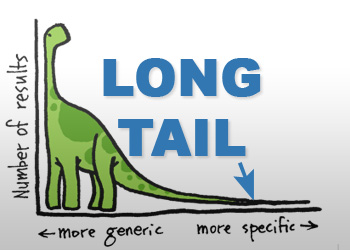
As a kid, I used to absolutely adore dinosaurs. I thought I was a bit of a dinosaur expert and one fun “fact” I would tell all my friends who were willing to listen was that dinosaurs had brains in their butts. However, my dinosaur butt dreams came crashing down when I was much older and read that it was a myth, the double brain theory is not true! Why am I telling you this? It’s a loose segue into good keyword practices for SEO. As you can see in the image above, that’s a thunder lizard, more commonly known as a Brontosaurus and it has quite a long tail. In term’s of keywords for SEO, there are Fathead and Longtail keywords. You should utilize both of those but in varying degrees.
Let’s say you know what Fathead keywords to use already, that’s the head of the dinosaur (tiny, nonspecific and generic). Say you have a healthy snacks company, good Fathead keywords would be “Healthy Snacks” “Granola Bars”. The issue with Fathead keywords is that they’re highly competitive and you have to pay highly to bid on them. So where do you go from here? Oh yeah! Choose some really good Longtail keywords.
Longtail keywords are more specific and have less competition therefore you’re bidding less. Going back to the dinosaur story, these are the brainier and smarter choices you can make hence the brain in the butt. If a healthy snacks company does some research into Longtail keywords, they would come up with things like: “snacks for people on a diet” “Healthy snacks that only uses sea salts” and whatever else would work for the company. Furthermore, it’s really important to a decent amount of keyword research because you want to target people who are further down the marketing funnel since they’d essentially have their wallet out and are ready to purchase. To conclude, use the brain in the butt theory and come up with some really smart Longtail keywords because they just might ensure you’re looking at some good conversion rates.
